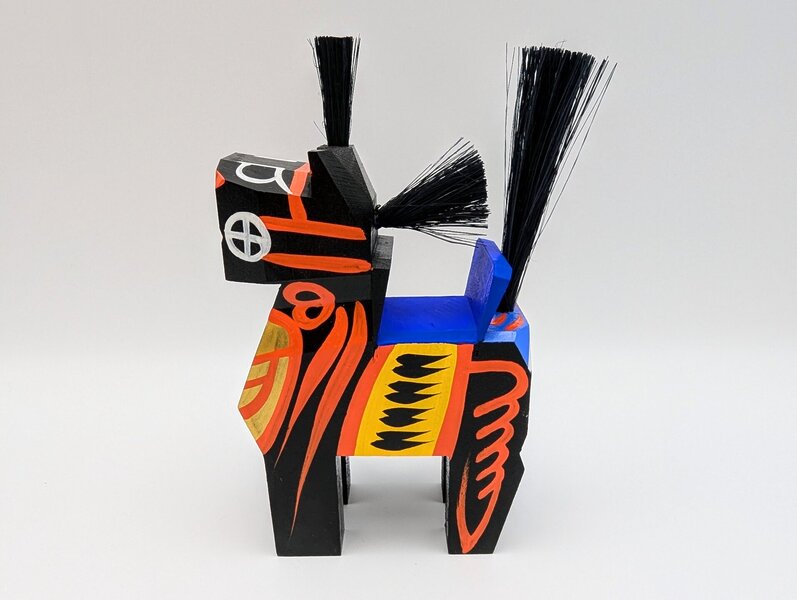
Miharukoma - A local toy with the legendary legend of Sakanoue Tamuramaro [Koriyama City, Fukushima Prefecture]
table of contents
Nishida-cho, Koriyama City, Fukushima Prefecture. In the area where there was a village called Takashiba village of the Miharu domain during the feudal period, there is a local toy called ``Miharukoma'', which
What is Miharukoma?
Miharukoma is a toy for children in the shape of a horse, mainly made by cutting out square wood from a paced wood, and is considered one of the "three major Japanese komas"

There are basically two types of komas, white komas and black komas, and they are made by painting them red, black, gold, etc., applying glue to give them a shine, and planting hemp manes and tails.

The Miharukoma created by Hikoji Hashimoto is famous as the first folk art item in Japan to be used as a motif on New Year's stamps

The official name is "Takashiba Kinma"
, was originally called ``Takashiba Kinma'' because it was a wooden horse made in Takashiba Village

During the Edo period, the Miharu domain was famous for its horse production, and capturing, breeding, and selling wild horses became a major industry for the domain. When the horse was distributed, the name Miharu-bred horse ``Miharu Koma'' was used, similar to the brand name we use today.
In other words, ``Miharukoma'' was originally a brand name associated with ``actual horses,'' and it is thought that ``Takashiba Kinma'' began to be called by that name from the early to mid-Showa period. Masu.
By naming it ``Miharukoma,'' which has long been known as a brand name in other regions, it may have been an attempt to raise the profile of ``Takashiba Kinma'' as a craft. Hmm.
The legend of Miharukoma
There is also a legend about the origin of Miharukoma.
During the Heian period, Sakanoue no Tamuramaro, a great general of the Conquerors, went to this area to conquer a demon named Otakimaru who lived in a cave on Mt. Otakine. On that occasion, Enchin, a monk from Kiyomizu-dera Temple in Kyoto, gave him 100 small wooden pieces as amulets.

The battle soon began, but Sakanoue Tamuramaro's army was forced to struggle due to fatigue from the long journey. At that time, 100 horses appeared out of nowhere, and the soldiers mounted them and attacked Mt. Otakine, successfully defeating Otakimaru.
After that, the 100 horses suddenly disappeared.
The next day, one of the villagers found a wooden carved piece sweating near Takashiba Village, and a wise man in the neighborhood told him that it was one of the 100 wooden pieces made by Enchin of Kyoto. When I heard that, I made my own food to replace the missing 99 animals.
A few years later, the one piece he had picked up disappeared before he knew it, and when he gave the remaining 99 replica pieces to the children in the village, the children who played with them grew up healthy, and in a childless home, the number of pieces was 3 pieces per day. It is said that if you offer soybeans to a wooden horse, you will be blessed with children.
Takashiba Deco Yashiki, the birthplace of Miharukoma, which continues to be made today
The Takashiba Deco mansion in Nishida-cho, Koriyama City, Fukushima Prefecture (formerly Takashiba Village, Miharu Domain), which continues to make Miharukoma, is said to be its birthplace.
It is famous nationwide as the home of toys, with four craftsmen's houses preserving their own traditions and continuing to make Miharu papier-mâché dolls, papier-mâché masks, and daruma dolls.

, Hikoji Mingei, has continued to consistently make Miharukoma from wood carvings .
Miharukoma<Information>
- Name: Takashiba Deco House Hikoji Folk Art
- Address: 80-1 Takashibadateno, Nishida-cho, Koriyama-shi, Fukushima 963-0902
- Phone number: 024-972-2412
- Official URL: http://dekoyashiki-hikojimingei.co.jp/





![[Koriyama City, Fukushima Prefecture] You can see a nationally designated natural monument! What is the pegmatite dike at Kashima Ojingu? IMG_0375](https://jp.neft.asia/wp-content/uploads/2025/02/IMG_0375-150x150.jpeg)
![[Koriyama City, Fukushima Prefecture] What is “Takashiba Deco House”? A tourist destination where you can talk with locals! Enjoy shopping, experiences, and learning [Koriyama City, Fukushima Prefecture] What is “Takashiba Deco House”? A tourist destination where you can talk with locals! Enjoy shopping, experiences, and learning](https://jp.neft.asia/wp-content/uploads/2024/02/P2022183-150x150.jpg)
![Takashiba Deko Mansion is a local toy village that remains in the territory of the former Miharu Domain [Koriyama City, Fukushima Prefecture] Entrance to Hikoji folk art](https://jp.neft.asia/wp-content/uploads/2024/12/IMG_0674-EDIT-150x150.jpg)
![[Koriyama City, Fukushima Prefecture] Space Park's planetarium is certified by Guinness! Enjoy the world's tallest space theater starry sky and children](https://jp.neft.asia/wp-content/uploads/2018/03/dffa2e7b1a9ce8ec5e557f31f5957d83_s-150x150.jpg)
![[Fukushima Prefecture] What is the legend of Princess Hagi? Legends that remain in Bandai Atami, a popular hot spring area Hagihime legend](https://jp.neft.asia/wp-content/uploads/2022/03/f545c0e0eac88556682361aab93aadfd-1-150x150.jpg)
![[Koriyama City, Fukushima Prefecture] Aiming to become a city in love with carp|Koriyama City spreading the local flavor of “carp cuisine” 4237561_m](https://jp.neft.asia/wp-content/uploads/2022/03/4237561_m-150x150.jpg)
![Its history is 1900 years old! ? Asaka Kunizo Shrine, a historic shrine that has been passed down since the time of the Yamato Imperial Court [Fukushima Prefecture] Asaka Kunizukuri Shrine](https://jp.neft.asia/wp-content/uploads/2022/11/IMG_4027-150x150.jpg)
![[Koriyama City, Fukushima Prefecture] What is the lucky park that was built in Kaiseiyama Park, a famous spot for cherry blossoms? rakki-kouenn](https://jp.neft.asia/wp-content/uploads/2023/03/rakki-kouenn-150x150.jpg)











